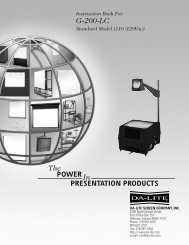Dataton WATCHOUT User's Guide
Dataton WATCHOUT User's Guide
Dataton WATCHOUT User's Guide
Create successful ePaper yourself
Turn your PDF publications into a flip-book with our unique Google optimized e-Paper software.
Optimizing Playback of Large<br />
Videos<br />
When using overlapping display areas, you may want to play a video that fits<br />
within one display but also intrudes into adjacent, overlapping displays. Even<br />
though the video fits entirely within one display, it normally also plays on those<br />
other, intersecting displays. While this is generally not a problem, it places<br />
unnecessary burdens on those display computers by using two or more<br />
computers to play a video that could actually be handled by just one. In particular,<br />
this can be an issue if you want to play other videos on those display<br />
computers at the same time, as a single display computer may not be capable<br />
of sustaining more than one large video at a time.<br />
This can all be avoided by compositing the video onto the display after the<br />
edge-blend has been applied. This avoids the edges of the video becoming<br />
feathered by the edge blend, allowing it to play entirely within one display<br />
computer. To do this, specify the edge blend layer in the Timeline Settings<br />
dialog box (see “No Edge-blend Past Layer” on page 130), then put the video<br />
below the last edge blended layer of the Timeline (as indicated by a heavy,<br />
black line).<br />
◆ HINT: Depending on the image shown on adjacent displays, you may<br />
have to add a black box behind the video, since adjacent displays may<br />
otherwise superimpose their part of the overlap on the video.<br />
94 Chapter 7: Production




